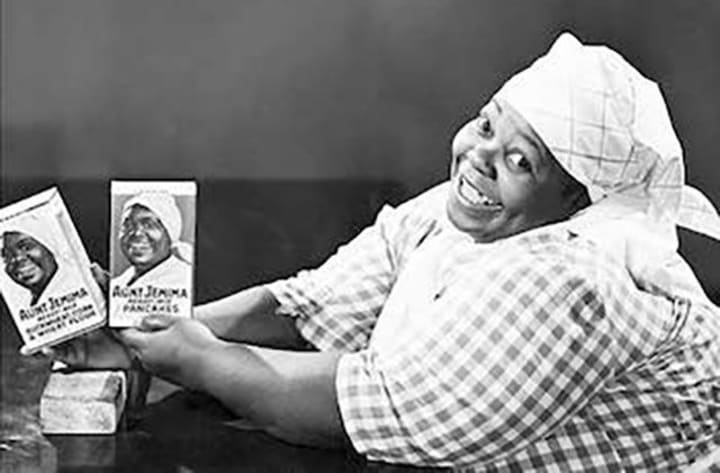Inside the Unique, Historical , Friendly and No-Longer-Around Eatery At Disneyland
All About Aunt Jemima’s Pancake House
Introduction
Aunt Jemima's Pancake House (also known as Aunt Jemima's Kitchen) was a classic family-style eatery that was situated in Frontierland during the 1950's. In other words, it was located in Disneyland and was inspired by old-fashioned American history. In fact, the restaurant revealed a lot of American history. It was one of the most controversial attractions at the park and had a shocking past both inside and outside of the amusement park.

The birth of the Aunt Jemima pancake/waffle mix brand
In 1889, Chris Rutt, a former newspaper editor from Missouri purchased a small flour mill with his business partner Charles Underwood. The two businessmen created a pancake recipe, and then started marketing their mix with the use of a character named Aunt Jemima, which was based on a song written by popular minstrel show performer, Billy Kersands. The character was based on the "mammy" stereotype that depicted slavery and domestic servitude during the post-emancipation era of Black people, and not on the ugly reality of life for both the enslaved and liberated Black people of America in the 19th century.

The pancake and waffle mix brand had a rough start. Due to its limited advertising budget and poor means of distribution, it was not very successful. However, RT David, who was the owner of both the RT Davis Milling Company and one of the biggest Missouri flour mills purchased the brand in 1890. Since RT Davis had experience in advertising, the brand managed to gain momentum after he purchased the brand. The vintage representation of the loving household servant with a famous pancake recipe helped establish the mix as a common staple within American households. Because of the varying portryals of Aunt Jemima done by different women throughout its history, the brand eventually gained popularity. Former slave Nancy Green first accepted the role in 1893, and appeared at the worlds famous exposition in Chicago that same year. Since the brand attracted large crowds of potential consumers, Aunt Jemima's products increased to the national stage. Once Nancy Green died in 1923, the role was taken over in the coming decades by women like Anna Robinson, Anna Short Harrington and Edith Wilson, who often appeared as the character in person, as well as on some of the newly contributed entertainment mediums like the radio and television.

The further expansion of Aunt Jemima
By the 1950's, Aunt Jemima became a significant part of everyday life in the United States, because of the continuous advertising budget. Quaker Oats acquired the brand back in 1926 and some companies were eager to find different sites of the park to promote their own brands. Quaker Oats sponsored and fully operated the quick service, family-style eatery.
In the mid-1950's, the amusement centre celebrated it's opening day, while the restaurant was close to being complete. On August 17th 1955, Aunt Jemima's Pancake House finally opened, only several months after the remainder of the park did.

The restaurant offered a wide range of pancake, waffles and other breakfast dishes such as the Mark Twain Special and the Wild Mountain Blueberry Pancakes. If people craved a sugary breakfast, their best bet was to visit Aunt Jemima's Pancake House. For a decade, it became the most famous eatery in the park. It included both an outdoor patio and an indoor dining area for patrons to take advantage of. While restaurant customers were dining, Aunt Jemima entertained them by talking and singing to them. On National Pancake Day, guests would participate in a pancake race down Main Street with a pancake skillet in their hands.
Long after Aunt Jemima's Pancake House closed its doors, Disney took over operations their operations in 1967. Quaker Oats terminated the sponsorship in July 1970 with Disneyland, and the restaurant was never to be operated by any outside companies, even during potential sponsorships. The park even removed Aunt Jemima as the spokeswoman, since the character belonged to Quaker Oats.

About the Creator
Talia Devora
Poetess, visual artist and lifestyle/quiz writer! My pastimes include reading, sleeping, gaming, music, fitness, etc! Be yourselves, be kind and value life! Let's connect and be friends!
My IG accounts: @tdwrites24 & @tdcreates97
Reader insights
Outstanding
Excellent work. Looking forward to reading more!
Top insights
Excellent storytelling
Original narrative & well developed characters
Expert insights and opinions
Arguments were carefully researched and presented
Eye opening
Niche topic & fresh perspectives
Heartfelt and relatable
The story invoked strong personal emotions
On-point and relevant
Writing reflected the title & theme






Comments (1)
Such a fascinating piece on the history of the Aunt Jemima brand!